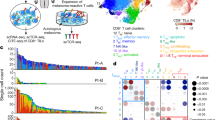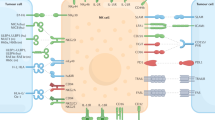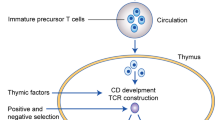Abstract
The mechanism by which cytotoxic T lymphocytes (CTL) recognize and lyse target cells is largely unknown. Recently, two lymphocyte cell-surface glycoproteins, Lyt-21–4 and LFA-1 (lymphocyte function-associated antigen)5–8, have been implicated in the killing activity of murine CTL. This suggestion was based mainly on the unique ability of antibodies directed against Lyt-21–4 and LFA-15–8 to inhibit cytotoxicity of CTL by affecting the killer cell. Lyt-2, a glycoprotein composed of subunits of molecular weights of 30,000–35,000 (30–35K), has been proposed as a common marker for CTL9, essential for specific recognition of target cells10. This view, however, is incompatible with other results11–14. The newly detected LFA-1 molecule, containing subunits of 95K and 180K5–8,15, is associated with the ability of CTL to bind target cells16,17. Most analyses of CTL structure–function relationships are ambiguous since they have been obtained with heterogeneous CTL populations. We have recently developed CTL-hybridomas which lyse specifically allogeneic tumour cells in vitro18 and grow independently of exogenous stimuli19. In this study we have tested the relevance of Lyt-2 and LFA-1 antigens to cytotoxicity by analysing the CTL-hybridomas with a panel of anti-LFA-1 and anti-Lyt-2 monoclonal antibodies. We show that two monoclonal CTL-hybridomas have the phenotype LFA-1+ and Lyt-2− and that their killing activity is inhibited by anti-LFA-1 but not by anti-Lyt-2. The results suggest that LFA-1 is involved in CTL-cytotoxicity, while Lyt-2 molecules are not required.
This is a preview of subscription content, access via your institution
Access options
Subscribe to this journal
Receive 51 print issues and online access
$199.00 per year
only $3.90 per issue
Buy this article
- Purchase on Springer Link
- Instant access to full article PDF
Prices may be subject to local taxes which are calculated during checkout
Similar content being viewed by others
References
Nakayama, E., Shiku, H., Stockert, E., Oettgen, H. F. & Old, L. J. Proc. natn. Acad. Sci. U.S.A. 76, 1977–1981 (1979).
Shinohara, N. & Sachs, D. H. J. exp. Med. 150, 432–444 (1979).
Hollander, N., Pillemer, E. & Weissman, I. J. exp. Med. 152, 674–687 (1980).
Sarmiento, A., Glasebrook, A. L. & Fitch, F. W. J. Immun. 125, 2665–2672 (1980).
Davignon, D., Martz, E., Reynolds, T., Kürzinger, K. & Springer, T. A. Proc. natn. Acad. Sci. U.S.A. 78, 4535–4539 (1981).
Kürzinger, K., Reynolds, T., Germain, R. N., Davignon, D., Martz, E. & Springer, T. A. J. Immun. 127, 596–602 (1981).
Pierres, M., Goridis, C. & Golstein, P. Eur. J. Immun. 12, 60–69 (1982).
Dialynas, D., Loken, M., Sarmiento, M. & Fitch, F. W. Mechanisms of Cell-Mediated Cytotoxicity (eds Clark, W. R. & Golstein, P.) 547–556 (Plenum, New York, 1982).
Cantor, H. & Boyse, E. A. Cold Spring Harb. Symp. quant. Biol. 41, 23–31 (1977).
Dialynas, D. P., Loken, M. R., Glasebrook, A. L. & Fitch, F. W. J. exp. Med. 153, 595–604 (1981).
Swain, S. L., Dennert, G., Wormsley, S. & Dutton, R. Eur. J. Immun. 11, 175–180 (1981).
Vidovic, D., Juretic, A., Nagy, Z. A. & Klein, J. Eur. J. Immun. 11, 499–504 (1981).
Pierres, A., Schmitt-Verhulst, A.-M., Buferne, M., Golstein, P. & Pierres, M. Scand. J. Immun. (in the press).
MacDonald, H. R., Thiernesse, N. & Cerottini, J. C. J. Immun. 126, 1671–1675 (1981).
Kürzinger, K., Ho, M. K. & Springer, T. A. Nature 296, 668–670 (1982).
Davignon, D., Martz, E., Reynolds, T., Kürzinger, K. & Springer, T. A. J. Immun. 127, 590–595 (1981).
Golstein, P. et al. Immun. Rev. (in the press).
Kaufmann, Y., Berke, G. & Eshhar, Z. Proc. natn. Acad. Sci. U.S.A. 78, 2502–2506 (1981).
Eshhar, Z., Waks, T., Oren, T., Berke, G. & Kaufmann, Y. Curr. Topics Microbiol. Immun. 100, 11–17 (1982).
Kaufmann, Y., Berke, G. & Eshhar, Z. Lymphokines, Monoclonal, T Cells and Their Products Vol. 5 (eds Feldman, M. & Schreier, M. H.) 277–289 (Academic, New York, 1982).
Springer, T. A., Davignon, D., Ho, M.-K., Kürzinger, K., Martz, E. & Sanchez-Madrid, F. Immun. Rev. 68 (in the press).
Ledbetter, J. A. & Herzenberg, L. A. Immun. Rev. 47, 63–89 (1979).
Gibson, D. M., Taylor, B. A. & Cherry, M. J. Immun. 121, 1585–1590 (1978).
Fan, J., Ahmed, A. & Bonavida, B. J. Immun. 125, 2444–2453 (1980).
Swain, S. L. & Fanfili, P. R. J. Immun. 122, 383–391 (1979).
Swain, S. L. Proc. natn. Acad. Sci. U.S.A. 78, 7101–7105 (1981).
Simpson, E. Nature 295, 366–367 (1982).
Kaufmann, Y. Transplantn Proc. (in the press).
Author information
Authors and Affiliations
Rights and permissions
About this article
Cite this article
Kaufmann, Y., Golstein, P., Pierres, M. et al. LFA-1 but not Lyt-2 is associated with killing activity of cytotoxic T lymphocyte hybridomas. Nature 300, 357–360 (1982). https://doi.org/10.1038/300357a0
Received:
Accepted:
Issue Date:
DOI: https://doi.org/10.1038/300357a0
Comments
By submitting a comment you agree to abide by our Terms and Community Guidelines. If you find something abusive or that does not comply with our terms or guidelines please flag it as inappropriate.



